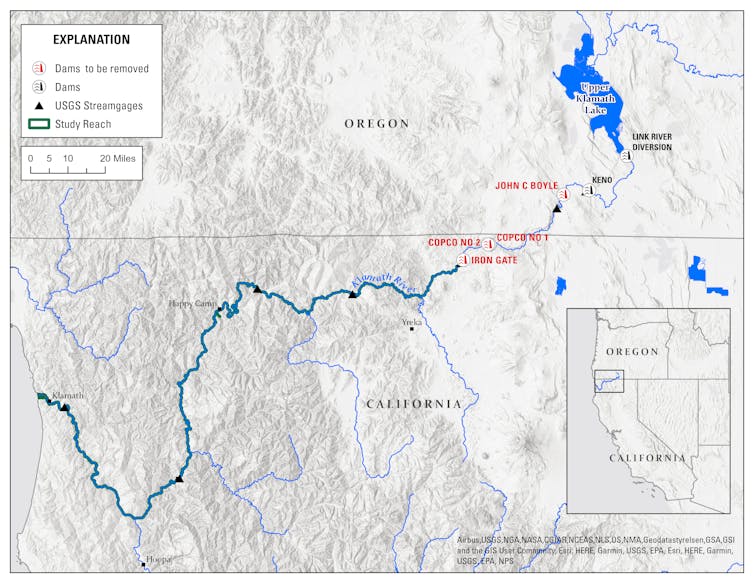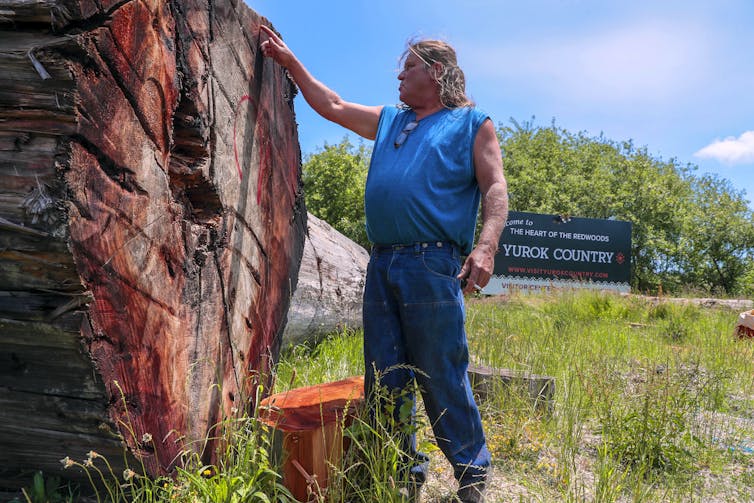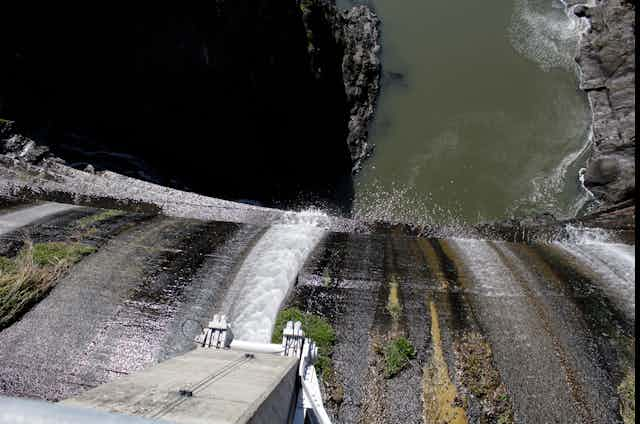The Klamath River runs over 250 miles (400 kilometers) from southern Oregon to the Pacific Ocean in Northern California. It flows through the steep, rugged Klamath Mountains, past slopes of redwood, fir, tanoak and madrone, and along pebbled beaches where willows shade the river’s edge. Closer to its mouth at Requa, the trees rising above the river are often blanketed in fog.
The Klamath is central to the worldviews, history and identity of several Native nations. From headwaters in Klamath, Modoc and Yahooskin-Paiute lands, it flows through Shasta, Karuk, Hupa and Yurok homelands. The Yurok Tribe has legally recognized the personhood of the river.
Historically, the Klamath was the third-largest Pacific salmon-producing river on the West Coast. The river supported abundant and diverse runs of native fish, including Chinook and coho salmon, steelhead trout, Pacific lamprey, green sturgeon, eulachon smelt and coastal cutthroat trout. Most of the Klamath in California has been designated since 1981 as “wild and scenic” – the strongest level of protection for free-flowing rivers.
People and fish of the Klamath River have been interconnected for millennia. But dams and irrigation systems built before the 1960s – along with other pressures, such as logging, mining and overharvesting – have separated fish from their spawning habitats and Indigenous cultures from sacred fish.

Recognizing this harm, state, federal and tribal agencies now are removing four of the Klamath’s six dams to let fish migrate farther upstream to historical habitats. The target completion date is 2024. This US$450 million project is the largest dam removal in the world.
Dam removals have catalyzed ecological rebound in other rivers, including the Elwha in Washington state and the Kennebec and Penobscot in Maine. As scholars working in Native American studies and freshwater ecology, we see the Klamath dam removal as an opportunity to right historical wrongs, improve depleted native fish populations and strengthen an understanding of the relationships between fish and Indigenous peoples.
People, fish and infrastructure
Resident fishes of the upper Klamath are highly endemic, meaning that they do not occur anywhere else in the world. They represent a unique collection of species from an ancient river that historically flowed into the Great Basin – a swath of arid lands across present-day Nevada and western Utah – before connecting to the lower Klamath River about 1.8 million years ago. Many fishes, particularly Chinook salmon, steelhead and coho salmon, annually migrated to or near the headwaters of the Klamath River to spawn.
As early as 1895, hydroelectric operations began to change the Klamath’s hydrology. In the early 1900s, multiple small regional hydroelectric companies consolidated to form California Oregon Power Co., or Copco, and the U.S. Bureau of Reclamation began developing water storage and diversion projects.
White settlers in California had already been violently attempting to eradicate Native Americans since the mid-1800s. Dam building ushered in a new phase of attempted removal for tribes whose lives and cultures were centered along the rivers. Farming communities and lumber companies invaded the ancestral homelands of the Yurok and Karuk peoples.

Declining fisheries
Permitting processes in the heyday of Western dam construction did not consider impacts on Indigenous nations or fisheries. Construction of Copco 1 blocked all fish migration to the Klamath’s upper reaches starting in 1912. Subsequently, Copco 2, J.C. Boyle and Iron Gate dams further shortened fish migrations, cutting off access to approximately 400 miles (650 kilometers) of productive spawning and rearing habitat. None of these dams included passage systems to help fish access upstream habitats.
Today, wild spring-run Chinook are largely absent from the basin, except for a small population associated with the Salmon River and another population released from a hatchery on the Trinity River. Wild spring-run Chinook have declined by 98% from historical baselines.
Fall-run Chinook still return to the basin in moderate to small numbers, partly because two hatcheries on the Klamath produce and release up to 12 million juveniles annually. According to a 2002 estimate, between 20,000 and 40,000 wild fall-run Chinook salmon now return from the ocean annually, down from approximately 500,000 historically.
Other native fishes in the Klamath Basin are also in severe decline. The Coho salmon, shortnose sucker, Lost River sucker, bull trout and euchalon all are federally listed as threatened or endangered. Conservationists have petitioned regulators to list other species, including spring-run Chinook, steelhead and lamprey.

Impacts on tribal nations
Development in the Klamath Basin has pitted agricultural interests against tribal nations and fish, particularly during dry years. Lack of fish passage systems and lower river flow have contributed to fish declines and disease.
Losing salmon along the Klamath is traumatic for Native nations, which see the fish as a cultural and spiritual keystone. For them, working to remove the dams and protect the salmon is a commitment and a responsibility.
As Yurok tribal member Brook Thompson, a restoration engineer, stated in a recent article:
“My people have lived on the Klamath for thousands of years, and I know that the salmon today are the descendants of those my ancestors managed. These salmon are a direct tie to my ancestors – the physical representation of their love for me. The salmon are my relatives.”
Tribes have legal rights to protect their fisheries and, ultimately, their cultural survival. In Western water law, rights often follow a first-in-time logic, meaning that the first party to claim or appropriate water holds the right to it. According to the Winters doctrine, established in a 1908 Supreme Court ruling, tribal water rights extend back to the dates when reservations were created.
The Klamath River Reservation was established primarily for Yurok on the lower Klamath in 1855, long before water development upstream. Upriver, lands were recognized for the Klamath tribes in 1864.
In 1954 Congress terminated federal recognition for the Klamath Tribe. Three decades later, however, in the 1983 case U.S. v. Adair, the U.S. Court of Appeals for the 9th Circuit recognized that the tribe retained enough water rights to protect its treaty-guaranteed hunting and fishing rights on former reservation land.
A state quantification process affirmed in 2012 and reaffirmed in 2021 that tribes had the most senior water rights in the upper Klamath Basin. The federal government is responsible for ensuring in-stream flows that will sustain the Klamath tribes’ fishing rights, as well as agricultural deliveries to upstream farmers – whose rights generally date to the establishment of the federal Klamath Project in 1906.
Downstream, a series of court cases and a 1993 legal opinion from the Department of the Interior affirmed Yurok and Hoopa fishing rights. Tribes have legal priority, both upriver and downriver.
Welcoming salmon home
Removing the dams will begin to address the terms of the Yurok Tribe’s 2019 Resolution 19-40, which recognizes the rights of the Klamath River itself “to exist, flourish, and naturally evolve; to have a clean and healthy environment free from pollutants; to have a stable climate free from human-caused climate change impacts …” and the tribe’s right to “protect the Klamath River, its ecosystem, and species for the continuation of the Yurok people and the Tribe for future generations.”
Dam removal will encourage native and endemic fishes to return to the upper basin and access important spawning and rearing habitats. Fish population responses will probably vary, particularly during the first several years after removal.
However, salmon and trout have evolved to migrate upstream and access important headwater spawning and rearing habitats. Making this possible will support long-term recovery of these ecologically and culturally important species.
It also will promote the recovery of Indigenous peoples’ homelands and lifeways. In Yurok restoration engineer Brook Thompson’s words, “We’re all focused on finding solutions to bringing our salmon back home and creating a healthy life for them. Creating a healthy life for salmon means creating a healthy life for us as people.”
The authors thank Barry McCovey Jr., Director of the Yurok Tribal Fisheries Department, for reviewing this article and providing comments.

